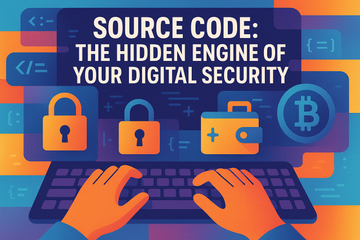You know what? We hardly ever think about what makes our favorite apps tick. Whether it's the calculator on your phone, the navigation in your new electric car, or the Bitcoin hardware wallet you use in the back of a bustling coffee shop, it all starts with one thing: source code. Before you yawn, let's be honest—understanding what source code really means is a bit like discovering the recipe behind the famous pie everyone raves about at Thanksgiving. Not glamorous, but utterly essential.
So, What Exactly Is Source Code?
Let me explain in plain terms. Source code is basically a huge set of instructions written by coders (sometimes called programmers or devs, if you’d rather sound cool at a party). These instructions tell computers, smartphones, and microchips what to do. Imagine a symphony score, each note carefully placed, but here, each line is typed in familiar languages like Python, JavaScript, or C++. Instead of drums and violins, you’ve got loops, functions, and variables.
Sounds simple, right? But here’s where things get just a little wild. Unlike the easy stuff your barista can manage with a coffee machine, computers are painfully literal. One misplaced comma, and poof—the whole thing can break. You ever forget the eggs in a cake recipe? That’s kind of how brutal one typo can be in source code.
From Scribbles to Software
Think of source code as a rough sketch before a painting comes alive. Developers put their ideas into source code, designing everything from the user interface (the stuff you tap) down to the way your crypto hardware wallet securely signs off transactions in the background. (If you’ve ever used a Ledger or Trezor wallet, their engineers sweat over this code to keep your Bitcoin safe—no small task!)
Once written, this source code doesn’t just leap out performing magic on its own. It goes through what's called compilation or interpretation. A compiler turns the code into binary—zeros and ones the machine gobbles up. An interpreter translates on the fly, kind of like a live sports commentator putting player actions into words. Either way, there’s a transformation from human-readable lingo to computer language. The digital gears start spinning.
Why Does Transparency Matter?
Now, you might be wondering, 'Why should I care?' Honestly, it matters more than you think. Take open-source projects, like Bitcoin or Linux—anyone can look at the source code, suggest tweaks, or spot bugs. It’s the ultimate group project, except no one's dragging you down because they didn’t even read the instructions. You get tighter security, more eyes catching mistakes, and often, faster innovation.
Contrast that with closed-source, or proprietary, software. Here the code is locked up, often to protect secrets or fend off hackers. Sometimes it just means the company wants to keep its secret sauce. If you're using crypto wallets, this difference can be huge. Some folks feel better knowing the code running on their Ledger device can be scrutinized by anyone.
Quick List: Open vs. Closed Source Code
- Open-source: Anyone can see, use, and improve the code. Think community potluck, but with software.
- Closed-source: Only the original devs know what's cooking inside. Sometimes for good reason, but you might not know what’s in the stew.
Sneaky Bugs and the Human Touch
Here’s something most people don’t realize—source code is written by real human beings, not robots. (Well, not yet, anyway.) And humans, even brilliant ones, miss things. The notorious Heartbleed bug? That slipped through the eyes of open-source developers and left millions exposed. It’s a solid reminder that source code, like anything hand-stitched, can have imperfections sewn into its digital fabric. That’s why regular updates and patches matter—ignoring them is like leaving the front door unlocked, hoping no one notices.
Devs learn to leave little breadcrumbs in their comments—notes for themselves or future programmers. Sometimes these comments are helpful; other times, they’re reminders that everyone occasionally runs low on caffeine or patience. It’s like jotting a 'don’t forget the milk!' on your shopping list.
Digging Deeper: Source Code’s Role in Crypto Hardware Wallets
Let’s circle back to something really topical: how source code shapes your crypto security. In the crypto space, trust isn’t just about branding—it hinges on transparency. Trezor, for example, has open source firmware so savvy users can actually verify what’s going on under the hood. Ledger, meanwhile, offers a mix of open and closed code, sparking debate in the crypto fanbase. Some feel safer with transparency, while others trust established brands.
This openness has real-world consequences. Imagine you’ve stashed your savings in Ethereum, and a bug in the code could risk your funds. With an open source project, someone might spot and fix the issue faster. With closed systems, you depend entirely on the company to protect you—trust, but verify (if you’re allowed to verify at all).
Source Code Isn’t Just for Geeks
Even if you never plan to write a single line of code, understanding the basics gives you power as a tech consumer. Want your favorite messenger app to actually respect your privacy? Check if its code is open-source. Curious why your old phone suddenly hates the latest update? Sometimes, the quirks are embedded deep in the code from years ago. Knowing that can dial down the frustration when things glitch out.
And hey, if you’re wondering if sourc code really matters in everyday life, consider this: source code runs everything from your smartwatch’s pedometer to airport security scanners. Any mistake or flaw can ripple through—sometimes with more excitement than anyone bargained for.
So, What’s Next?
The landscape is always changing. New languages pop up, old ones evolve, and programmers adapt. We’re seeing more use of AI in writing and reviewing source code, but the need for the human touch hasn’t faded. Creativity, intuition, and a knack for predicting user behavior make all the difference—after all, lines of code are just another way that humans solve problems, argue over choices, and sometimes leave the toilet seat up.
Next time you update an app or check your crypto balance, spare a moment to thank the source code (and the beating hearts behind it). Even though it’s hidden from view, that invisible network of logic is quietly shaping your digital world, one carefully crafted line at a time.











